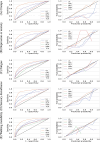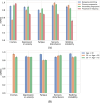Performance of machine learning models for predicting high-severity symptoms in multiple sclerosis
- PMID: 40414922
- PMCID: PMC12104369
- DOI: 10.1038/s41598-024-63888-x
Performance of machine learning models for predicting high-severity symptoms in multiple sclerosis
Abstract
Current care in multiple sclerosis (MS) primarily relies on infrequently obtained data such as magnetic resonance imaging, clinical laboratory tests or clinical history, resulting in subtle changes that may occur between visits being missed. Mobile technology enables continual collection of data and can pave the path for predicting complex aspects of MS such as symptoms and disease courses. To this end, we conducted a first-of-its-kind observational study called MS Mosaic. First, we developed and publicly launched a mobile app for collecting longitudinal data from MS subjects in the United States. Second, we ran the study across 3 years in order to capture complex patterns for this slow progressing disease. Finally, we retrospectively developed three classical ML methods and two deep learning models to accurately and continually predict the incidence of five high-severity symptoms (fatigue, sensory disturbance, walking instability, depression or anxiety and cramps/spasms) three months in advance.
© 2025. The Author(s).
Conflict of interest statement
Competing interests: The authors declare no competing interests.
Figures




Similar articles
-
Usability of a Mobile App for Real-Time Assessment of Fatigue and Related Symptoms in Patients With Multiple Sclerosis: Observational Study.JMIR Mhealth Uhealth. 2021 Apr 16;9(4):e19564. doi: 10.2196/19564. JMIR Mhealth Uhealth. 2021. PMID: 33861208 Free PMC article.
-
Evaluating the Utility of Smartphone-Based Sensor Assessments in Persons With Multiple Sclerosis in the Real-World Using an App (elevateMS): Observational, Prospective Pilot Digital Health Study.JMIR Mhealth Uhealth. 2020 Oct 27;8(10):e22108. doi: 10.2196/22108. JMIR Mhealth Uhealth. 2020. PMID: 33107827 Free PMC article.
-
Development of a brief clinician-reported outcome measure of multiple sclerosis signs and symptoms: The Clinician Rating of Multiple Sclerosis (CRoMS).Mult Scler Relat Disord. 2019 Oct;35:253-261. doi: 10.1016/j.msard.2019.06.024. Epub 2019 Jun 19. Mult Scler Relat Disord. 2019. PMID: 31437740
-
Multiple sclerosis update.Am J Manag Care. 2013 Nov;19(16 Suppl):s294-300. Am J Manag Care. 2013. PMID: 24494618 Review.
-
Predicting multiple sclerosis disease progression and outcomes with machine learning and MRI-based biomarkers: a review.J Neurol. 2024 Oct;271(10):6543-6572. doi: 10.1007/s00415-024-12651-3. Epub 2024 Sep 12. J Neurol. 2024. PMID: 39266777 Free PMC article. Review.
References
-
- Monteiro, M. et al. Multiclass semantic segmentation and quantification of traumatic brain injury lesions on head CT using deep learning: An algorithm development and multicentre validation study. Lancet Digit. Health2(6), e314–e322. 10.1016/S2589-7500(20)30085-6 (2020). - PubMed
-
- Saba, L. et al. The present and future of deep learning in radiology. Eur. J. Radiol.114, 14–24. 10.1016/j.ejrad.2019.02.038 (2019). - PubMed
Publication types
MeSH terms
LinkOut - more resources
Full Text Sources
Medical
Miscellaneous

